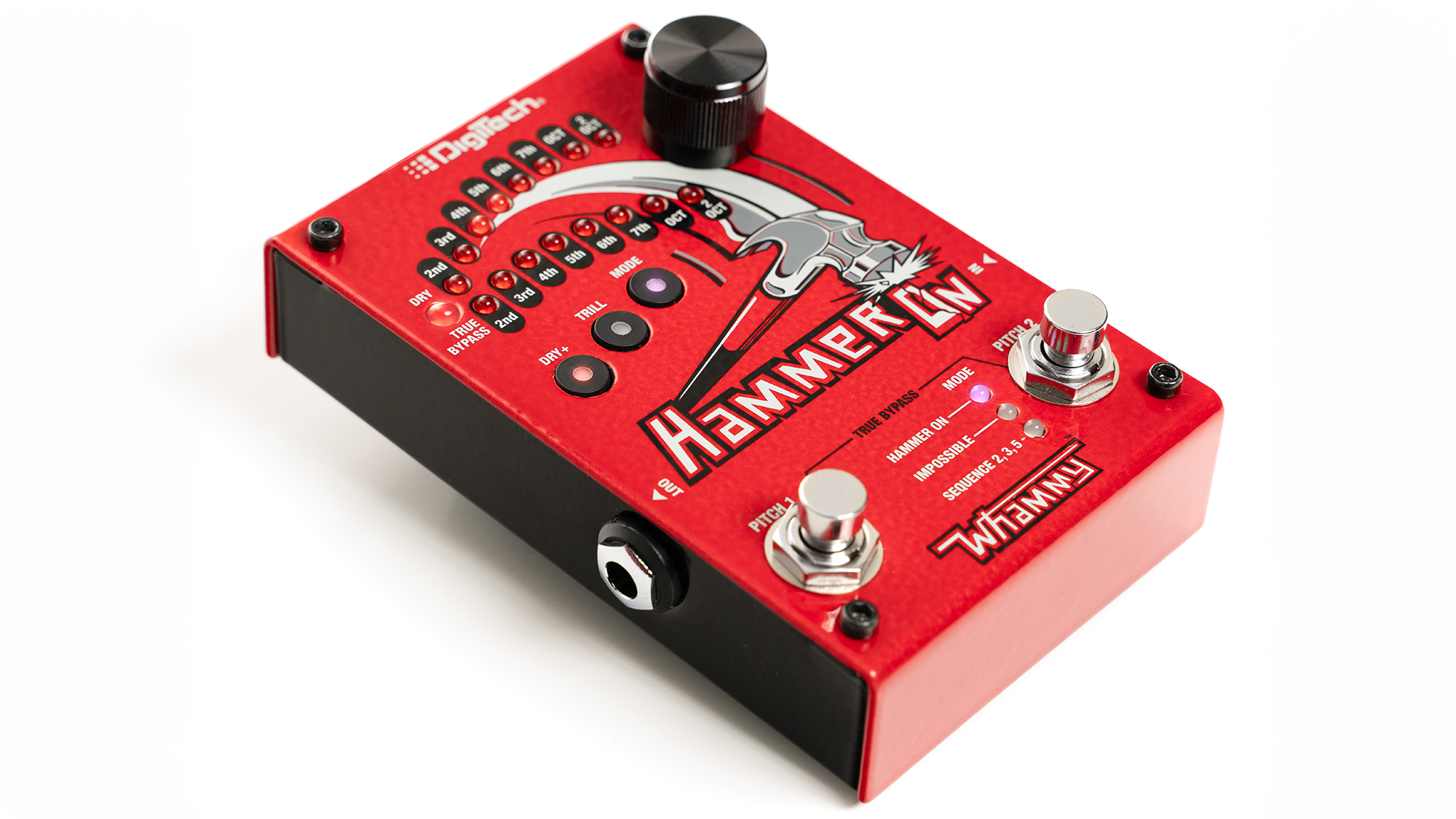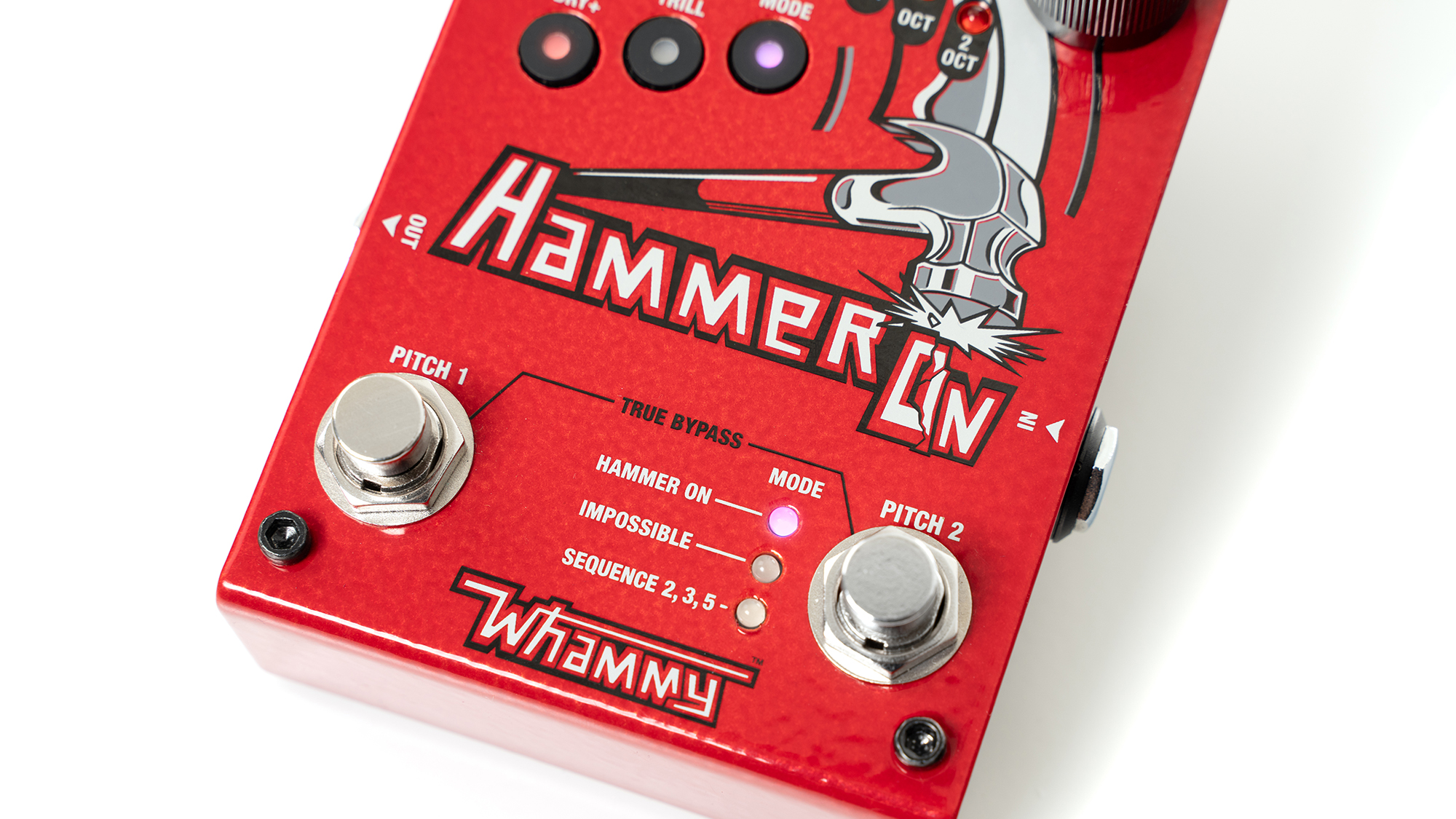GuitarPlayer Verdict
With seven modes, DigiTech's HammerOn Pitch Shifter pedal gives you instantaneous pitch shifting. Hammer-ons, trills, instant harmonies, drop and capo tunings, and programmable pitch sequences with trills are all on tap here, giving you the ability to create leaps and licks that would be physically impossible. And when you consider its use for dropping your guitar's tuning a step or two on demand, the HammerOn shows itself as a practical addition to your pedalboard.
Pros
- +
Capable of awesome fantastical tones as well as many practical applications
Cons
- -
None
You can trust Guitar Player.
The DigiTech Whammy family has a new member, and it’s a prodigious bundle of possibility. Like its predecessors that helped reinvent the sound of rock in the ‘90s via Jack White, Tom Morello and many other electric guitar visionaries, the HammerOn is capable of creating unprecedented tones, only available via electronic assistance. The HammerOn even has a dedicated Impossible Mode designed to facilitate fantastical intervallic feats that are simply unplayable physically.
The fundamental concept of the HammerOn stompbox is clearly indicated in the title. It facilitates precise pitch jumps as if you were hammering-on the fretboard with an extra hand, only using feet instead of fingers. But in fact, it’s a deep pedal that does much more.
The HammerOn’s primary controls are a pair of foot switches that raise or lower the pitch from a played note by chosen intervals. Unlike the original Whammy, which shifted a note with a keyboard-like portamento, these shifts happen precisely and instantaneously on the HammerOn, as the note leaps directly to the intervals assigned to the Pitch 1 and Pitch 2 foot switches.
The default shifts are up a 5th for Pitch 1 and up an octave for Pitch 2. Hit either while playing a note on a single string and it sounds as if you’d reached over with your plucking hand to hammer on either a 5th or an octave above. The Pitch 1 foot switch is dedicated to the hammer-on effect and it’s momentary, so the pitch shift holds until you let go, allowing you to toggle back and forth manually between the played note and the shifted one.

Do so with a chord, and it sounds as if a capo was placed above it by the given interval, like hammering on and off with as many as six fingers simultaneously. There are two global modes: Classic and Chords. Factory default is set to Chords, which doesn’t track single notes as well as Classic, but it’s much better for multiple notes.
The craziest element to the HammerOn pedal may be its practicality. DigiTech claims it offers seven pedals in one, and its Drop setting alone makes it worth keeping on your board in case you want to, say, drop the whole tuning a step or two without having to change axes, or raise the pitch of an entire chord structure without a capo. Add the insane amount of note shifting and sequencing available at your feet to incorporate on the fly, and it’s a potential game changer.
Engage the Trill button and the HammerOn will toggle back and forth automatically, like hitting the switch repeatedly at a selectable rate. Use the dry+ function to hear the played note coupled with the intervallic shift, like a double-stop. Add the Trill back and it toggles the sound of both notes back and forth.
All the latest guitar news, interviews, lessons, reviews, deals and more, direct to your inbox!
It’s easy to select different intervals of pitch shifting. Hit and hold either pitch switch and turn the control knob to select from the intervallic options conveniently laid out in an upper and lower row. Let go to assign that interval to the selected switch, and you’ve got a new landscape of harmonic options at your feet.

You can always tell which interval is assigned to which pitch switch because one of the 16 intervallic LEDs will light each time you hit the switch. Including the root tone there are 27 options, as you can raise it chromatically up or down an octave, plus two bonus shifts that take the root pitch a whopping two octaves in either direction.
Pitch 2 foot switch functionality works in close conjunction with the Mode button, and there are three options. It starts out in Hammer-On Mode where it behaves just like Switch 1 as indicated by a purple light. Hit the button again and it turns red to indicate Impossible Mode. It’s a variant of Hammer-On mode that alternates between two pitches.
Now you can use multiple hits of the Pitch 2 switch to alternate between, say, up a perfect fourth and down a perfect 5th. Remember, Pitch 1 is still available to be set on, say, two octaves up. So things start getting rather “impossible” really quick as you’ve got three disparate notes to toggle between with your feet while your fingers are still available to play whatever comes to mind. Is it blown yet?
We’ve only scratched the surface of this fathoms deep pedal. Sequence Mode is the third option for the Pitch 2 foot switch, and there are three sequence varieties. A blue light indicates that you’re in Sequence Mode with the default setting of two notes per sequence, meaning you can assign two different pitches that will sound with each press of the switch before returning to the root tone on the third press.

Hit the Mode button again and a teal light indicates a three-note sequence. One more press and a green light indicates a five-note sequence. Yes, you can engage the Trill effect in Sequence mode to automate the process to sound as if you’ve hit the Pitch 2 foot switch multiple times in succession.
You can go absolutely nuts with this pedal! If you’re looking for a new way to create insane sounds, look no further than the DigiTech HammerOn. But this device can be used for way more than ear candy.
I got mine just as I was about to sub in on a funk gig for a jazzy cat that’s far more harmonically advanced than me. The HammerOn was perfect for providing a shortcut to some further “out” stuff than I would normally play, without ever having to venture into fretboard territory beyond my ability to navigate.
And then there’s the creativity factor, which is absolutely off the charts. During this review process as I walked through the functionality of the pedal, numerous ideas for riffs, licks and chord progressions popped up seemingly out of nowhere. There were chord progressions I’d never otherwise consider, riffs and licks that ventured off into extended ranges I wouldn’t have accessed, and then the truly impossible stuff, such as hammering on below a fretted note and then instantaneously shooting the moon two octaves above.

Sonically, the HammerOn sounds a lot like other members of the Whammy family with which we’ve become familiar. Is it always completely realistic? No, but that’s also part of the charm. You can enter the global Classic mode to get superior individual note tracking, but I understand why Chord mode is the default, because anything more than two or three tones shifted together sounds quite jumbled in Classic mode, whereas Chord mode can accommodate shifting a full barre chord.
Upward shifts tend to sound a bit better than lowered ones. The higher the range, the more Chipmunk-like the tone. Very high tones can sound almost like whistles, but I didn’t mind much for single notes because that’s part of the established Whammy-tone lexicon at this point, and the harp-like character of the “capoed” chords sounds charming in its own unique way as well.
The closer to the fretted note or especially the played chord, the more realistic the effected tone sounds. So if you simply want to drop a half step to play along with, say, Stevie Ray or EVH without having to retune, then yes, it’s remarkably authentic. It works on an acoustic-electric guitar as well, but the weird thing then is that you hear the unfettered acoustic sound from the guitar while you hear the dropped or raised tuning from the amp.
I haven’t had this much fun with a pedal since I can’t remember when. I dig the electronic nature of the far-out tones, and it was a gas to watch heads spin at the Boom Boom Room when I’d hit the HammerOn to leap into octave-up licks that seemed to pop in from another sonic dimension.
It also solved a few very practical problems such as facilitating dropped tunings without need of a second instrument on the gig, and making me sound like a more creative lead player than I truly am! One person said, “How did you make your guitar sing like that? It was like Peter Frampton or something!”
I’d enthusiastically recommend the DigiTech HammerOn to absolutely anyone out for sonic adventure. Kudos to DigiTech for further expanding the horizon of possibility.
SPECIFICATIONS
CONTACT digitech.com
PRICE $279
CONTROLS Selector knob (pitch shift interval; trill speed), Dry+ button, Trill button, Mode button
FOOT SWITCHES Pitch 1, Pitch 2
I/O Standard ¼ " input and output, 9VDC jack (adapter included)
LEDs Dry/true bypass, interval indicators (1 row up and 1 row down): 2nd, 3rd, 4th, 5th, 6th, 7th, Oct, 2 Oct; Dry+, Trill, Mode: Hammer On, Impossible, Sequence 2, 3, 5
EXTRAS True Bypass
POWER 9V 300mA
DIMENSIONS 5.12" x 3.57" x 1.84" (LxWxH)
WEIGHT 1.12 lbs
PRO Capable of awesome fantastical tones as well as many practical applications
CON None
Jimmy Leslie is the former editor of Gig magazine and has more than 20 years of experience writing stories and coordinating GP Presents events for Guitar Player including the past decade acting as Frets acoustic editor. He’s worked with myriad guitar greats spanning generations and styles including Carlos Santana, Jack White, Samantha Fish, Leo Kottke, Tommy Emmanuel, Kaki King and Julian Lage. Jimmy has a side hustle serving as soundtrack sensei at the cruising lifestyle publication Latitudes and Attitudes. See Leslie’s many Guitar Player- and Frets-related videos on his YouTube channel, dig his Allman Brothers tribute at allmondbrothers.com, and check out his acoustic/electric modern classic rock artistry at at spirithustler.com. Visit the hub of his many adventures at jimmyleslie.com


